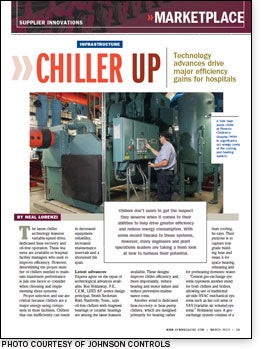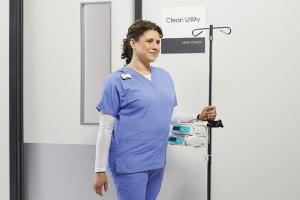Chiller up
 Chillers don't seem to get the respect they deserve when it comes to their abilities to help drive greater efficiency and reduce energy consumption. With some recent tweaks to these systems, however, many engineers and plant operations leaders are taking a fresh look at how to harness their potential.
Chillers don't seem to get the respect they deserve when it comes to their abilities to help drive greater efficiency and reduce energy consumption. With some recent tweaks to these systems, however, many engineers and plant operations leaders are taking a fresh look at how to harness their potential.
The latest chiller technology features variable-speed drive, dedicated heat recovery and oil-free operation. These features are available to hospital facility managers who seek to improve efficiency. However, determining the proper number of chillers needed to maintain maximum performance is just one factor to consider when choosing and implementing these systems.
Proper selection and use are critical because chillers are a major energy-using component in most facilities. Chillers that run inefficiently can result in decreased equipment reliability,increased maintenance intervals and a shortened life span.
Latest advances
Experts agree on the types of technological advances available. Ron Holdaway, P.E., C.E.M., LEED AP, senior design principal, Smith Seckman Reid, Nashville, Tenn., says oil-free chillers with magnetic bearings or ceramic bearings are among the latest features available. These designs improve chiller efficiency and, more importantly, reduce bearing and motor failure and reduce preventive-maintenance costs.
Another trend is dedicated heat-recovery or heat-pump chillers, which are designed primarily for heating rather than cooling, he says. Their purpose is to capture low-grade building heat and reuse it for space heating, reheating and for preheating domestic water.
"Central geo-exchange systems represent another trend for both chillers and boilers, allowing use of traditional air-side HVAC mechanical systems such as fan coil units or VAV [variable air volume] systems," Holdaway says. A geoexchange system consists of a vertical or horizontal ground-source closed loop, a pond or other surface-water feature coupled to the building's HVAC system to reject or add heat to the building as required.
"Design features such as heat recovery options, ice-making capability and free-cooling are not necessarily new technologies but these and other energy-saving features are being specified more frequently today than in recent years," he notes.
Richard D. Hermans, P.E. HFDP, director of training and advanced applications for Daikin McQuay, Minneapolis, says modular chiller designs are becoming popular, as are variable-speed drives and oil-free magnetic bearing compressors. Controls continue to evolve, he adds, and soon will include an interface to future smart electric grids. Today's smart controls know when it's better to run multiple chillers at part-load, he notes.
Elsewhere, the chiller-heater is enjoying a resurgence in health care applications. This involves a refrigeration machine specially built to produce unusually hot condenser water that can be used for heating domestic hot water or to produce reheat water. "This concept has been around for a long time but is making a comeback, with new designs of these machines now available," Hermans notes.
Tube efficiency is another important trend in chiller technology, says Derrick Shoemake, project engineer for Hudson Technologies, Pearl River, N.Y., which recently purchased Efftrack (Efficiency Technologies Inc.), Tulsa, Okla. Tubes are getting more efficient by utilizing surface enhancements such as rifling techniques, which provide greater heat transfer through a larger surface area, he notes.
More efficient compressors are making chillers more cost-effective as well, he adds. "Some new compressors have magnetic bearings, which not only reduce friction and heat, but reduce noise levels as well. The downside to magnetic bearing compressors, however, is [that] the size of chillers available is usually less than 700 tons."
Push for perfection
Just how efficient are the latest chillers and what level can they achieve? According to Hermans, no chiller can surpass the perfect Carnot efficiency. However, the technology of the newest chiller systems has gotten close to this level of perfection when the chillers are running at part-load. "This suggests that some chiller types should be sized for peak load, but operated at part-load as much as possible. In fact, in some climates, it may be more efficient to use air-cooled chillers, which have excellent part-load efficiency and use no water for evaporative cooling towers and no condenser water pump," he says.
There is a growing trend for the use of more efficient air-cooled chillers, Holdaway agrees. Air-cooled chiller efficiency has increased significantly in the last few years with options for variable-speed drives on the compressors and condenser fans and control options to permit variable-chilled water flow. In fact, air-cooled chillers may be the best choice for a facility when evaluated on a life-cycle cost analysis.
"The problem is the industry is approaching a point of diminishing returns on the improvements of chiller efficiency," Hermans explains. "Our attention must now turn to combining these high part-load efficiency chillers with improved auxiliary equipment and system efficiencies. Our metric has changed from full-load equipment performance to systemwide energy consumption."
When it comes to choosing the best type of chiller for a hospital, there is no one-size-fits-all template, experts agree. Hospitals present unique challenges. Special equipment such as MRI machines may require a 40-degree F water temperature for cooling. Surgical rooms may require lower temperatures than comfort cooling and, of course, the chiller plant must be operational 24 hours a day, seven days a week.
Hospitals are unique because they have substantial "base load" that occurs year-round, regardless of climate or outdoor conditions, says Brandon Jackson, LEED AP, director of HVAC equipment sales, North America, Johnson Controls, Milwaukee. In 2005, Johnson Controls acquired York International, a leading manufacturer of heating and cooling equipment. "Large loads can be served with many types of chillers, but high-efficiency, variable-speed, water-cooled centrifugal chillers typically are chosen because they are efficient and financially justifiable," he notes.
"Depending on the size of the hospital's base load, an ideal scenario would be to consider heat pump-style chillers. A heat-pump chiller removes heat from the building's cooling loop and transfers it to the building's heating loop at temperatures up to 170 degrees F. At these temperatures, heat-pump chillers often can handle the entire cooling and heating load of a hospital without having to turn on additional boilers. This style of chiller can be centrifugal or screw compressor-based. In either case, they would be water-to-water style heat pumps."
Because downtime is not an option in health care environments, the ability for a chiller to come back online quickly after a power surge or electrical spike is critical, Jackson adds. As a result, there is a growing preference for chiller systems that utilize quick-start technology. This enables a chiller to recover instantly from a dead state to full cooling capacity in a matter of seconds versus traditional systems that often take 15 minutes or longer.
A critical decision
When it comes to sizing and the decision to use one large chiller versus multiple smaller units in a hospital, the typical arrangement is for N+1 redundancy, experts agree. Three centrifugal chillers, each sized for 50 percent of the design load, provide this N+1 redundancy, which allows two chillers to handle the total load. If one chiller fails, a standby unit ensures that the total load can be served. However, there are other issues to consider.
Determining the proper number of chillers to maintain overall equipment performance and building load is the first priority, says Tom Franaszek, business manager for chiller products, Carrier Corp., Farmington, Conn. "Very few facilities today use a single water-cooled chiller, regardless of the application," he explains. "Using too few chillers can impact plant performance negatively or result in capacity shortfalls. Using too many chillers also can impact plant performance negatively while increasing the installed cost as more infrastructure (i.e., pumps and piping) is required.
"Some facility managers may want to change the quantity of chillers to achieve better IPLV (integrated part-load value)," he notes. "This strategy often results in higher HVAC expenses as IPLV is a single-chiller metric and does not always correlate to better overall plant performance, especially when pumps and towers are included."
Because of the challenges that hospitals pose, facility managers should focus on the use of variable-speed drives in chillers, Franaszek adds. An electrical engineer should ensure that the hospital's electrical system will remain compliant with IEEE-519 (Institute of Electronic and Electrical Engineers) standards after variable-speed chillers are installed.
However, a less expensive and more practical solution is to install variable-speed drives with low harmonic content. "Variable-speed drives are available that produce less than 5 percent total harmonic distortion when calculated using the input circuit breaker as the point of common coupling," he notes. "This helps prevent 'electrical noise' from the drive from impacting the building's electrical system where it could disturb other sensitive electrical devices."
Refrigerants
With hydrochlorofluorocarbons (HCFCs) being phased out, what type of refrigerants are recommended for new chiller equipment? Experts agree that the refrigerant industry is in the midst of a balancing act — addressing environmental impacts with the efficiency and safety (i.e., toxicity and flammability) of refrigerants. HFC-134a and HFC-410A are the standard today and will be in use for many years. However, while HCFC-123 is being phased out for new production, it will be a viable refrigerant in use for many years.
According to Shoemake of Hudson Technologies, HFC-134a and HCFC-123 are the two most common refrigerants used in new larger-scale chillers. While they are not as thermodynamically efficient in the vapor-compression cycle as older, phased-out refrigerants, improvements in chiller technology have removed any barriers to migrating from the older refrigerants, he notes.
"Most HCFCs are already phased out of new equipment production and any remaining options will be eliminated soon," says Jackson of Johnson Controls. "For smaller chiller or unitary air-conditioning systems, it is typical to use HFC-410A with scroll compressors."
Health care facility managers should choose chiller equipment that has an adequate supply of refrigerant (for maintenance purposes) that will last the life of the equipment, advises Hermans of Daikin McQuay. "Refrigerant supplies have been available from recycled and recovered sources, even for refrigerants that have been phased out," he says.
"However, some reclaimed and recovered refrigerants have been subject to volatile pricing," Hermans adds. "Even common refrigerants such as HCFC-22 have experienced this price volatility. After the next round of phase-outs, the less common refrigerants could suffer the same fate."
Neal Lorenzi is a freelance writer based in Mundelein, Ill., who regularly contributes to Health Facilities Management.
| Sidebar - For more information |
| For further details on the chiller systems featured in this month's "Marketplace" article, readers can contact the following vendors: »Carrier Corp. »Daikin McQuay »Hudson Technologies »Johnson Controls |




